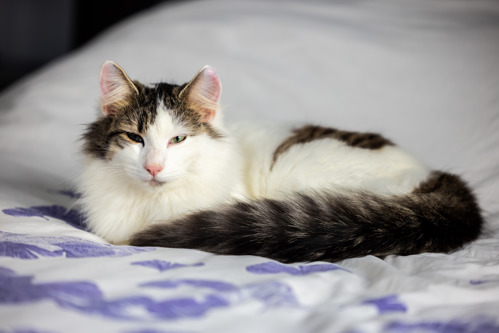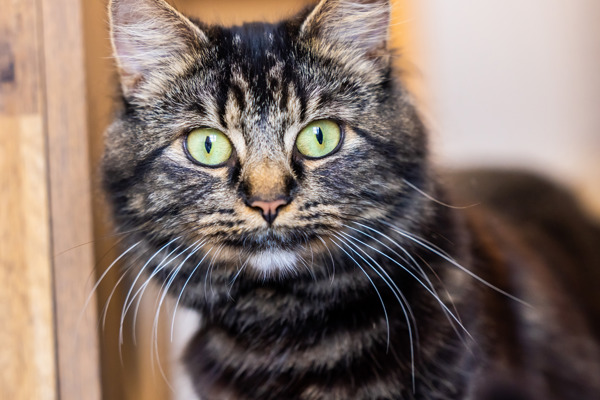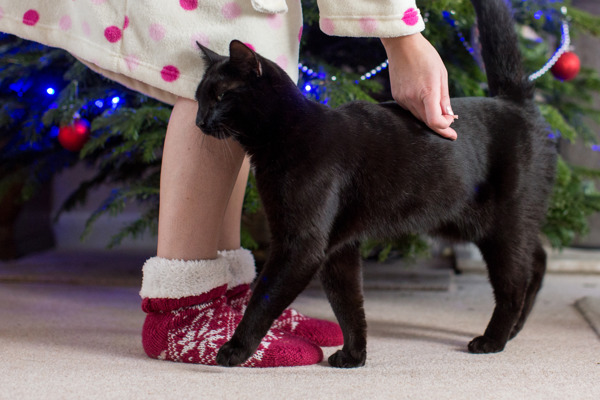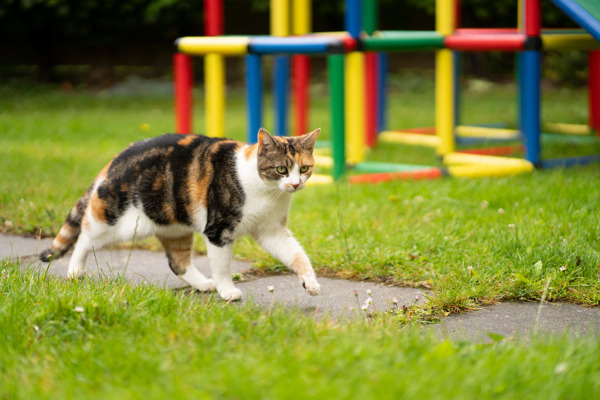How to read cat tail meanings
Fluffy tails, thin tails, long tails, stripy tails. Cats have all sorts of different tails. As well as looking magnificent, they are also important tools that help cats in their daily life.
Why cats have tails
A cat’s tail has many functions. It helps them balance, sense objects around them, and communicate with humans and other cats. It also helps keep them warm.
- Balance. Cats use their tail as a counterweight, giving them excellent balance. When they are walking along a narrow ledge, jumping or climbing, they adjust the position of their tail to reduce the risk of falling. It’s a bit like how we spread our arms to keep our balance when walking along a tightrope.
- Communication. A cat’s tail can tell you a lot about how they are feeling. Cats mainly communicate their mood using body language. Their tail is an important tool for this. Scroll down to find our guide on how to read your cat’s tail meanings.
- Sensory input. A cat’s tail contains several nerve endings, so they can sense when something touches their tail. This helps them to tell what’s happening behind them, so they know if something is sneaking up on them.
- Warmth. If a cat is feeling cold, they can wrap their fluffy tail around their body like a blanket to keep them warm. Find out more about keeping cats safe in cold weather.
Cat tail meanings
Why do cats wag their tails? What does it mean when a cat’s tail is twitching? Discover what the position and movement of your cat’s tail can tell you about how they are feeling.
- Tail pointing straight up. This means your cat is feeling happy and confident. If the fur at the base of the tail puffs up, this may mean they are overstimulated. It’s best not to stroke them, as they could bite you. Find out more about why cats bite.

- Tail pointing straight up and shaking/quivering. This could mean your cat is excited to see you. But it can also happen when a cat is spraying pee or ‘fake spraying’, also known as ‘pseudo spraying’. This is a sign that your cat is stressed. Find out more about spraying
- Tail pointing up and curved at the top. If your cat’s tail looks a bit like a question mark as they walk towards you, this means they are happy to see you and saying hello

- Tail puffed up. If their whole tail puffs up, your cat is feeling scared or threatened. Puffing up their tails helps them appear bigger and more threatening to others, warning them to stay away
- Tail slowly wagging from side to side. This means your cat is feeling indecisive or getting ready to pounce on something

- Tail quickly wagging from side to side. This means your cat is feeling angry or upset
- Tail tucked underneath their body. This means your cat is feeing scared or stressed. Find out more about cat stress
- Tail twitching/flicking. This means your cat is feeling agitated
- Tail wrapped around you or another cat. This is like a hug from your cat. They only wrap their tails around people and other cats they like, as a friendly greeting
- Rapid or unusual movements of the tail. This could mean you cat is feeling frustrated or that they are in pain or discomfort. If you notice your cat wagging their tail in this way, along with other changes in their behaviour, get in touch with your vet. They can check if your cat has any health issues
Find out more about cat body language.
Do cats have full control of their tails?

Cats have full control of their tails, from the base to the tip. A cat’s tail is an extension of their spine, and they can move it voluntarily. It contains 19 to 23 bones called vertebrae. These bones are held together with muscles, ligaments and tendons that give the tail flexibility.
Why do cats chase their tails?
Some cats chase their tails as a form of play. Cats like to chase fast-moving objects as it reminds them of their typical prey, such as small rodents. If they see their tail moving out the corner of their eye, they might mistake it for prey or a toy and instinctively try to chase it.
Tail chasing behaviour is more common in kittens as they are learning to hunt and play. Adult cats may still chase their tails occasionally and this is completely normal. If your cat is chasing their tail regularly this could be a sign of boredom. Try encouraging them to play with cat toys, such as fishing rod toys, instead to keep them entertained. Find out how to play with your cat.
If your cat is really bored, they may start attacking and biting their own tail. If you notice this behaviour, speak to your vet for advice. Find out how to help a bored cat.
Why do some cats have no tail?
Some breeds of cat are born without tails or with very short tails.
The Manx cat, which originates from the Isle of Man in the Irish Sea, is the only breed of cat with a mutation that makes them tailless. It is thought this is caused by inbreeding among the small population of cats on the island.
Other breeds of a cat, such a Bobtail cats, are born with extremely short tails. This is also caused by a genetic mutation.
Cats with short tails or no tail at all use other methods to help them balance and communicate their mood. They primarily control their balance with their inner ear. They communicate using other body language cues and vocalisations such as meows.
Unfortunately, the mutation that affects their tail can also cause damage to their spine and nerves. This increases their risk of developing painful arthritis at a young age. Find out more about pedigree cats.
If a cat loses some or all their tail in an accident, they can often adapt quite well to living without it. After a while they will learn to compensate for the loss of their tail. They will use other methods to balance and communicate.
Why does my cat have a crooked tail?
There are two main reasons why your cat may have a crooked tail.
- Injury. If your cat has injured or broken their tail in the past, they may have a cooked or bent tail. If you notice a change in your cat’s tail, take them to the vet to get it checked out.
- Genetic mutation. Some Siamese cats have a kink in their tail, which is a natural feature of the breed. It’s becoming less common for Siamese cats to have crooked tails though. This trait is gradually being bred out.
5 facts about cat tails

- Most cat tails are between 25 and 28 centimetres (9.8 and 11 inches) long.
- The longest tail ever recorded on a domestic cat was 44.66 centimetres (17.58 inches). It belonged to Cygnus Regulus Powers, a Maine Coon cat from Michigan, USA. The longest tail on a living cat currently belongs to Cygnus’ brother, Altair. His tail measured 40.83 centimetres (16.07 inches) in October 2021 but may have grown even longer since.
- The bones in a cat’s tail make up around 10% of the total number of bones in their body.
- Domestic cats are the only cats who can walk with their tail straight up in the air. Other cats, including big cats like lions and tigers, can only walk with their tail horizontal or between their legs.
- A cat’s tail is very sensitive as it contains lots of nerve endings. This is why most cats don’t like having their tails touched. You should never pull on a cat’s tail as it would be very painful for them and could cause lasting nerve damage.




